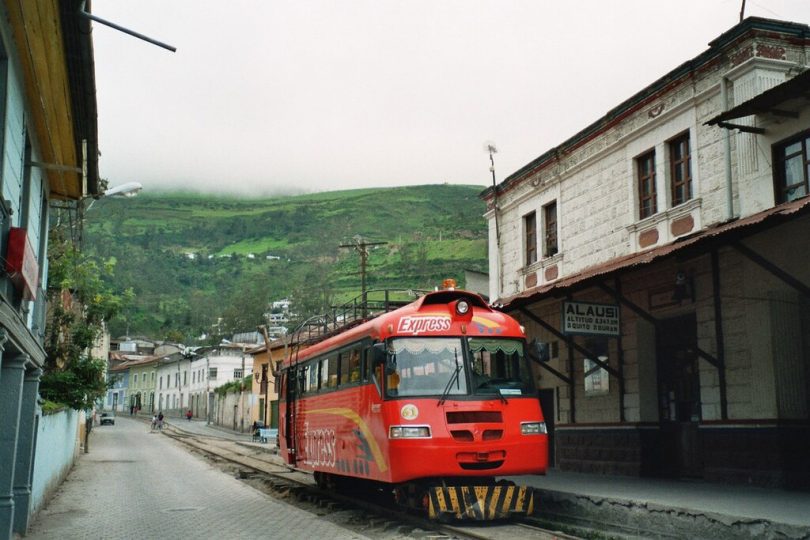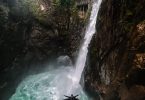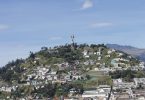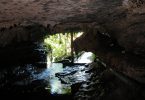Unfortunately, due to the devastating impacts of the COVID-19 pandemic, the Devil’s Nose Train operations have been suspended and the company has faced bankruptcy. Despite this, I still want to share the memories of our journey aboard this legendary train. The crisp Andean air whipping around us as we marveled at the breathtaking panoramas, the excitement of navigating such steep terrain by rail, and the warmth of the Ecuadorian people are memories that remain as vivid as ever.
During our time in Ecuador, one of the highlights that really stood out was visiting the legendary Nariz del Diablo, or “Devil’s Nose” train. I had read about this iconic railway route, which winds its way through the stunning Andes Mountains, but seeing it in person was something else. This isn’t just any train ride; it’s renowned for its incredible history and its impressive engineering—a true marvel that left both of us in awe.
The Nariz del Diablo train, though, has a bittersweet story. Despite being a must-do experience in Ecuador for years, the train eventually faced financial hardships and went bankrupt. It’s hard to imagine something so remarkable becoming part of the past, but that’s the reality.
I remember standing there, soaking in the atmosphere and thinking about the people who must have worked tirelessly to make this engineering feat a reality. The track hugs steep cliffs, zigzagging up the mountain with the kind of precision that makes you appreciate just how incredible human ingenuity can be.
As I walked along the tracks, my mind wandered to the cultural importance of this place, how it connected regions and people, and how it has left its mark on Ecuador’s history. While it’s no longer operational, visiting this site was still one of the most memorable parts of our journey, offering a glimpse into Ecuador’s past and a reminder of the challenges even the most remarkable projects can face.
In this article, I’ll share how you can experience this iconic spot for yourself, along with insights into its history, its engineering marvel, and its lasting cultural significance.
The History of Nariz del Diablo
During our trip to Ecuador, we were captivated by the story behind the Nariz del Diablo train, which was initially part of the Guayaquil–Quito railway project—a grand vision to connect the coastal city of Guayaquil with the capital, Quito. It’s one of those projects that make you appreciate the sheer determination and ingenuity of its time.
The construction of the Nariz del Diablo section, which began in 1899 and wrapped up in 1908, was nothing short of ambitious. As we learned more, it became clear that the primary goal of this part of the railway was to conquer the harsh and challenging terrain of the Andes Mountains. Standing there, imagining workers carving a path through such steep and rugged landscapes, was humbling.
The engineering was truly mind-blowing. With its intricate switchbacks, zigzagging tracks, and cliffside tunnels, the Nariz del Diablo train was designed to scale a nearly vertical rock face—hence the name “Devil’s Nose.” My wife was especially fascinated by how they managed to create a system that allowed the train to zigzag up the slopes in a series of switchbacks, overcoming what seemed like impossible odds.
As we stood at one of the viewpoints, I couldn’t help but feel a deep respect for the workers who faced not only the natural challenges but also the immense pressures to finish such a daring project. The whole experience left us both with a deeper appreciation for the ingenuity it took to build this railway over a century ago.
Where is the Devil’s Nose Train Located?
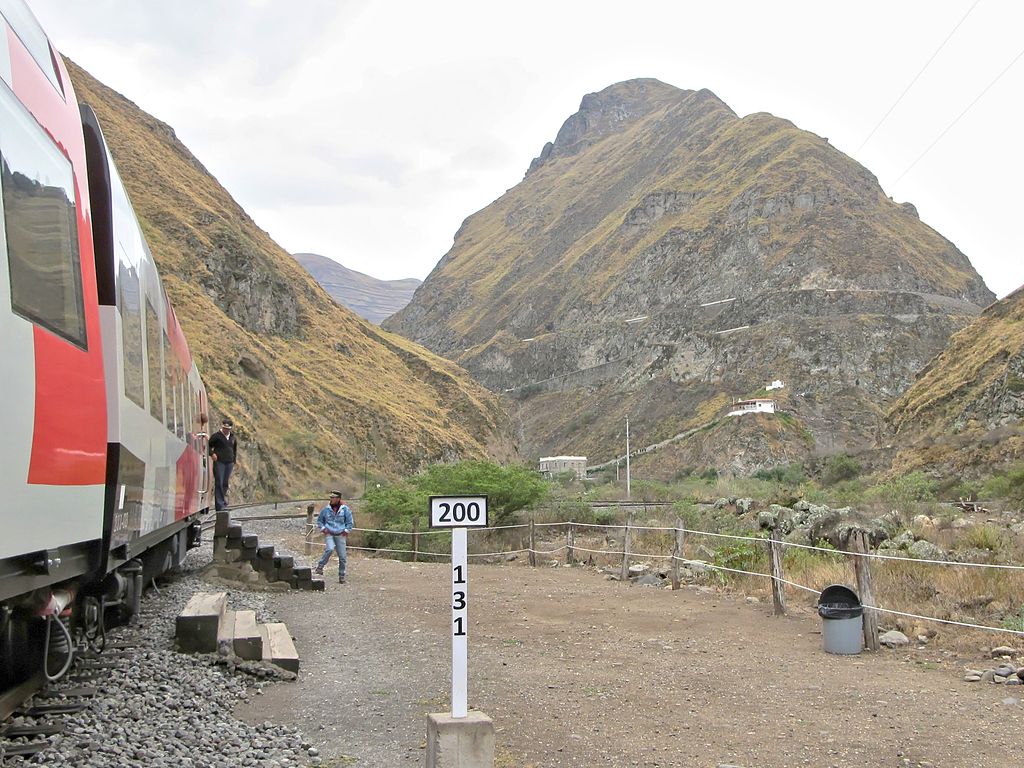
Photo Bbb-Commons // Wikipedia Commons
During our road trip through Ecuador, we made a stop in Alausi, a charming town in the Chimborazo province, known for being home to the famous Nariz del Diablo train. Nestled in the heart of the Andes, Alausi treated us to some of the most breathtaking scenery we encountered on our journey. The town itself feels like a hidden gem, surrounded by towering mountains and valleys that seem to stretch endlessly into the distance.
If you’re ever planning a road trip to Cuenca, I can’t recommend visiting Alausi enough. Not only is the scenery unforgettable, but taking the time to explore the story of La Nariz del Diablo adds a whole new layer to the adventure. We found it fascinating to see how this small town is so intricately linked to the rich history of the Devil’s Nose railway, and it’s the perfect detour to immerse yourself in Ecuador’s incredible landscapes and engineering history.
Whether you’re a history buff or simply looking for a unique experience in the Andes, visiting Alausi and witnessing the Devil’s Nose firsthand is something you won’t regret.
How To Get To The Devil’s Nose Train?
From Guayaquil
When we set out to visit La Nariz del Diablo, we knew it would be a bit of a journey, as it’s located quite a distance from the major city of Guayaquil. The drive to Alausi took us around 3.5 to 4 hours, winding through some beautiful stretches of Ecuador’s countryside. The views alone made the trip worthwhile, but it definitely required some planning.
During our research, we found that traveling by bus from Guayaquil to Alausi wasn’t the most straightforward option. At the time of our visit, there were no direct buses available. I remember feeling a bit relieved that we chose to drive because taking the bus would have involved multiple transfers and could have stretched the total travel time to over 8 hours. It’s something worth considering if you’re short on time or prefer convenience.
If you’re up for a road trip, though, I’d definitely recommend driving—it gives you the freedom to stop along the way and take in the stunning landscapes that Ecuador is famous for. Plus, reaching Alausi by car gives you more flexibility to enjoy the experience at your own pace.
From Quito
Even though Quito is farther from La Nariz del Diablo than Guayaquil, visiting this iconic spot from Ecuador’s capital is still a solid option. During our time in Ecuador, we considered both routes, and the drive from Quito to Alausi, taking around 5.5 to 6 hours, turned out to be quite manageable. Most of the journey follows Ecuador’s main highway (E35), which is much safer and easier to navigate compared to the more winding and sometimes nerve-wracking roads leading from Guayaquil.
One thing I appreciated about the Quito route is that the roads are generally more straightforward, without the steep cliffs and tight curves you might experience coming from other directions. It’s definitely a good option if you’re looking for a smooth ride.
For those who prefer taking the bus, Quito offers a convenient option as well. Direct buses are available, so you don’t have to worry about changing buses along the way. Even though the bus makes frequent stops, it’s nice not having to deal with multiple connections, which can add to the hassle of travel. The only downside is that taking the bus might extend your travel time by a couple of hours compared to driving. But if you’re not in a rush, it’s an easy and affordable way to reach Alausi. You can board any bus traveling between Quito and Cuenca since they all pass through Alausi, making the journey that much more accessible.
From Baños
When we were planning our trip from Baños to Alausi, we found the journey to be pretty straightforward, though it did require a bit of bus hopping. Baños is such an incredible place, and if you’re traveling from Quito to Alausi (or the other way around), I’d definitely suggest making a stop there for a few days. It’s the perfect way to break up the trip and experience Ecuador’s adventure capital, with its waterfalls, hot springs, and hiking trails.
Since there are no direct buses between Baños and Alausi, you’ll need to take a bus from Alausi to Riobamba first. From there, you’ll catch another bus to Baños. We made sure to check the schedules in advance, and with a quick connection, the whole trip took us around 3.5 hours. The bus ride was pretty scenic, and it gave us a chance to enjoy the mountainous landscapes of the region.
Stopping in Baños really added to the adventure, and it felt like a well-deserved break before continuing on to Alausi. If you’ve got the time, it’s well worth it.
Best Time To Ride the Devil’s Nose Train
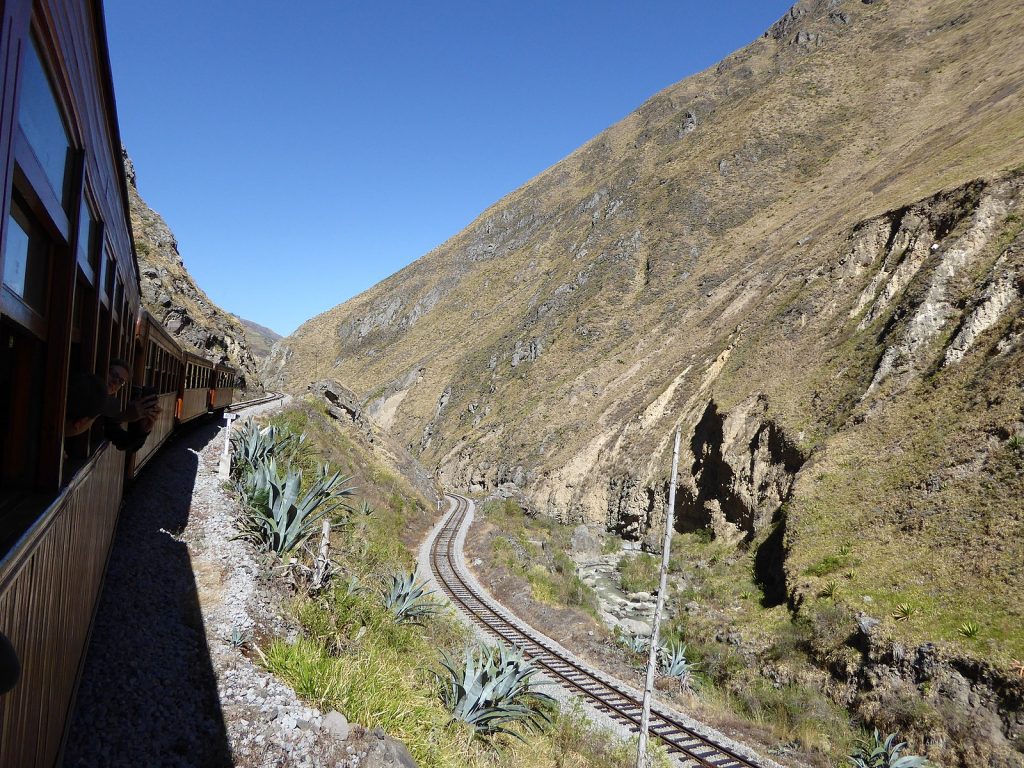
Photo Arabsalam // Wikipedia Commons
No matter the season, visiting La Nariz del Diablo is a fantastic experience. We were there during a time when the weather was quite pleasant, and it reinforced how this attraction is enjoyable all year round. But if you’re looking for the best possible experience, I’d recommend planning your trip between July and September.
During these months, there’s typically less rainfall, which made our visit much more comfortable. The skies were clearer, and while the weather was a bit cooler than in the summer, we actually preferred it that way. It felt refreshing as we explored the town of Alausi and took in the stunning views during the train ride. If you’re like us and prefer to avoid the rain, visiting in this period will make your trip even more enjoyable.
Nariz del Diablo Tickets and Schedule
From our experience, I highly recommend pre-booking your tickets online if you’re planning to ride the Nariz del Diablo train. It’s a popular attraction, and booking in advance ensures you’ve got a spot, plus you can select the best seats to make the most of the views. That’s what we did, and it made the whole process smooth and stress-free.
However, if you prefer being spontaneous or want to book in person, you can also get your tickets directly at the Alausi train station. The station is conveniently located right in the heart of town, and it’s where you’ll board the train. When we arrived, it was easy to spot and just a short walk from most places in town.
As for the cost, tickets are priced at USD 40 per person. The train operates every day except for Mondays, with two departures each day—one at 8 AM and another at 11 AM. We opted for the early 8 AM trip, and it was definitely worth it. The skies were clearer in the morning, which meant better visibility for soaking in the breathtaking scenery during the journey. If you’re after the best views, I’d suggest going for the early departure too!
Alausi Train Station
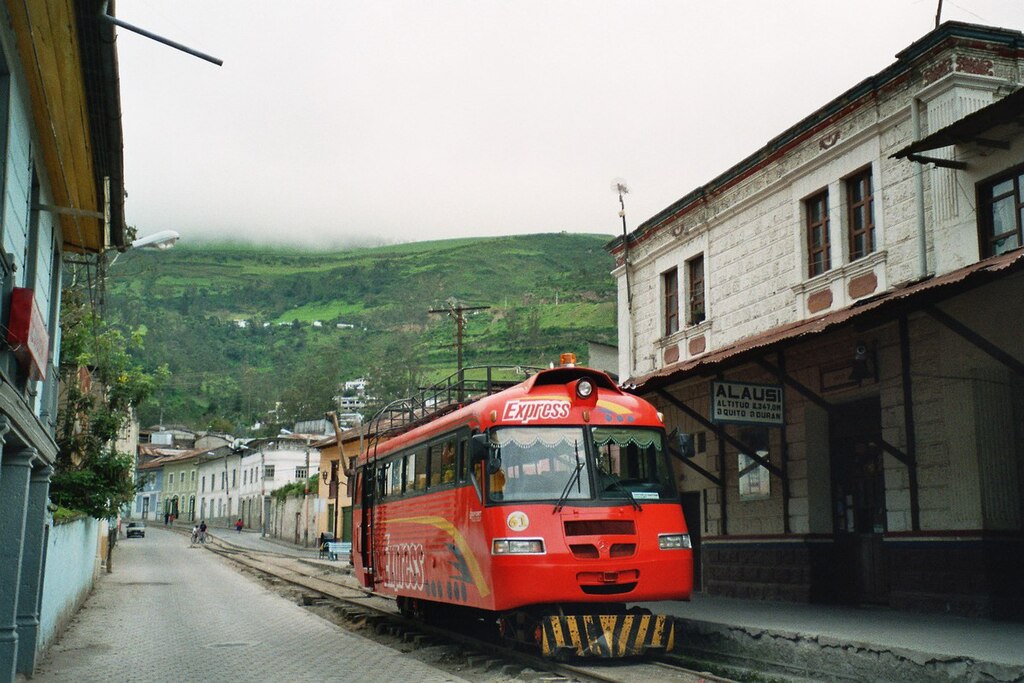
Photo Uwebart // Wikipedia Commons
Alausí’s train station is centrally located, making it super easy to find, which we appreciated when we arrived. If you have a bit of extra time before your departure, there’s a café nearby where you can grab a quick snack or coffee. We ended up doing just that, and it was a nice little pit stop before the ride. One tip: bring some snacks and drinks with you, as there are no food or beverage services available on the train itself.
The Nariz del Diablo train offers both double and single seats, arranged to face each other with a handy fold-out table in between. When we booked our tickets online, it was easy to spot these seats on the seating plan. The seats are spacious and comfortable, with a luggage rack overhead for smaller bags, which was convenient for our day packs.
Each carriage has a bathroom at the end, and there are plenty of rubbish bins placed along the aisle, so the space stays tidy throughout the journey. While there are no power sockets or Wi-Fi on board, we found it refreshing to disconnect and simply enjoy the breathtaking scenery outside the window.
The interior of the train is elegantly understated, with lovely wood paneling that adds to the charm of the experience. Everything felt well-maintained and clean, which made the journey all the more pleasant. It’s a simple yet relaxing environment, perfect for immersing yourself in the natural beauty of the Andes without distractions.
The Scenic Journey
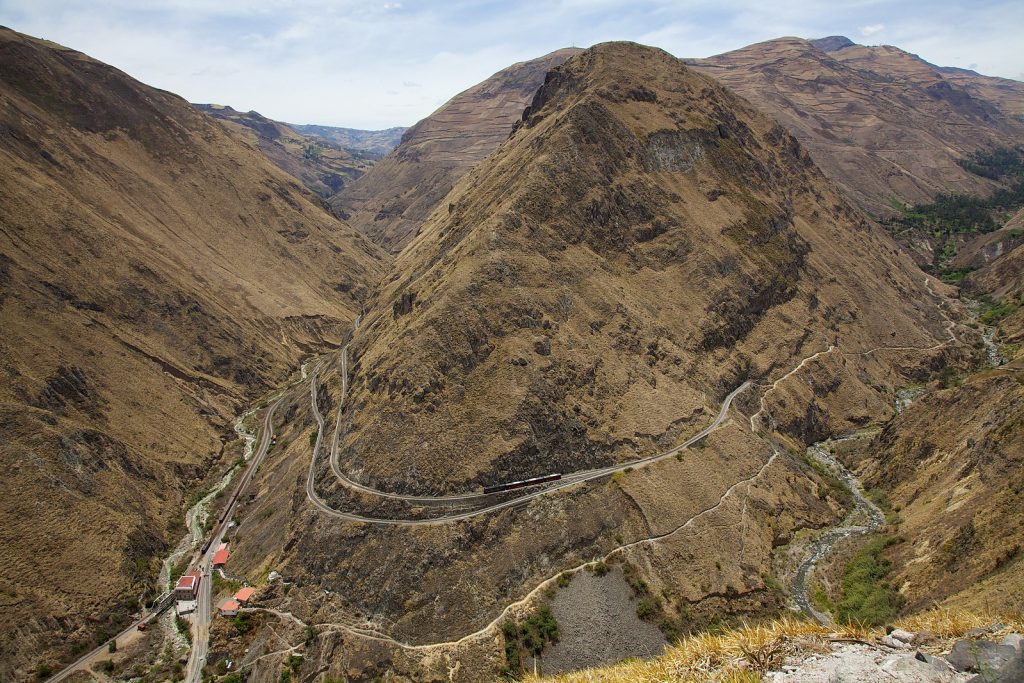
Photo David Brossard // Wikipedia Commons
Our journey began right on time at 8 AM as we boarded the Nariz del Diablo train, excitement building as we made our way through the quaint town of Alausí, surrounded by the dramatic beauty of the Andes Mountains. It felt like we were being embraced by the towering peaks as the city quickly faded into the distance, giving way to steep mountain slopes.
As the train descended an impressive 500 meters, we followed the winding tracks alongside a river, with towering cliffs on either side. The sense of adventure heightened with every turn as the landscape unfolded before us, each view more stunning than the last.
About 10 minutes into the ride, we reached Sibambe Station, a charming little stop nestled in the mountains. We had the chance to explore the area for about an hour, and I couldn’t resist heading up to the scenic viewpoints nearby. The panoramic vistas from there were absolutely breathtaking—one of those moments where you just want to stand still and take it all in.
For those curious about the history of the train, the station offered plenty of information, allowing us to delve deeper into the story behind this engineering marvel. My wife was particularly interested in learning more about how the train came to be, while I was captivated by the vibrant cultural dancing performance that took place. It was such a highlight of the trip, and what made it even more special was that visitors could join in. The energy was infectious, and it was a fun, unexpected way to connect with the local culture.
We spent about an hour at Sibambe Station, and when it was time to head back, everyone was instructed to board the train once more. The return journey took around 30 minutes, which was perfect since it gave us more chances to snap some stunning photos of the scenery. The mountains seemed even more magical on the way back, perhaps because we could take it all in without the anticipation of the descent.
After the lively performance, we had the chance to explore the open-air museum just a few meters from the tracks. It was a lovely spot to wander around, check out locally crafted souvenirs, and sample some tasty treats. One thing I can’t recommend enough is the cheese empanadas baked in a traditional clay oven—crispy on the outside, warm and cheesy on the inside, and at only $0.50 each, they were an absolute bargain! We grabbed a couple of those, and I couldn’t resist going back for more.
The small clay huts in the area had an authentic charm, and after finishing my empanadas, I still had enough time to take a few more pictures of the railway and enjoy a cup of coffee. I’d definitely add those empanadas to the list of must-try foods in Ecuador.
Once we’d soaked up all that Sibambe had to offer, it was time for the return journey to Alausí. This time, the train ride had an extra layer of magic as traditional Andean music played through the speakers. The music, paired with the views of the Andes, created the perfect atmosphere and made the trip back feel even more special. It was the kind of experience that leaves a lasting impression long after the journey ends.
Conclusion
The Devil’s Nose Train is without a doubt one of Ecuador’s top attractions, and after experiencing it firsthand, I can confidently say that the town of Alausi offers something special—a truly authentic cultural experience that’s worth the visit. While the ticket price might seem a bit steep at first, the whole experience is well worth it. Everything was so well-organized, which was refreshing compared to other long train rides we’ve been on.
The route itself is stunning. Even if you’re not a train enthusiast, the breathtaking scenery and the unique story behind the Nariz del Diablo make it an unforgettable journey for anyone. My wife and I were both captivated by the views and the overall ambiance. If you’re planning a trip to Ecuador, I highly recommend adding this train adventure to your itinerary. It’s a journey we thoroughly enjoyed, and we can’t recommend it enough to fellow travelers.

